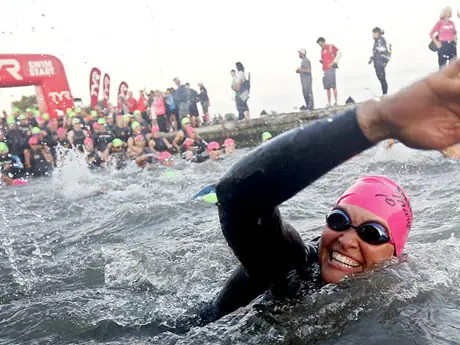
If you've ever trained for and completed an IRONMAN 70.3, at some point during yet another three-hour ride or 90-minute run, a familiar question probably fluttered across your mind: "Could I ever do an IRONMAN?"
Among all the other questions ("should I wear a one-piece tri suit?" "How long should my brick run be?") that one tends to speak the loudest, as we wonder whether we have the physical ability and time to be able to complete one.
As a coach myself, I'm asked this question frequently by athletes involved in half-distance triathlons. When they ask me if it's possible, my answer is always the same: Absolutely!
Guess what? There are very few limitations to crossing the finish line of an IRONMAN race. There are people with stage four cancer who have completed the distance and challenged athletes with prosthetic limbs who have beat the cut-off times to cross the finish line by midnight. Moms, dads, doctors and teachers have done it. The biggest hurdles in completing the full distance are actually somewhat unexpected: patience, finances, and perseverance. Some race experience never hurts to have in your arsenal, either.
More: The 4 Rules of Ironman Training
While it isn't necessary to complete triathlons of other distances, I do highly recommend building yourself up and getting comfortable at the IRONMAN 70.3 distance. When you complete your first IRONMAN 70.3, you're already more than halfway to the full—and you've already shown what it takes to commit both physically and mentally. And remember, your body has a way of doing what you ask of it.
Baby Steps
Natasha Van Der Merwe, professional triathlete and Director of Triathlon at Austin Aquatics and Sports Academy, notes that on average, time in the saddle really only builds approximately 30 minutes per week when you start to ramp up from the half to the full distance. That's why having an IRONMAN 70.3 fitness base is so valuable.
"You definitely don't go from a three-hour ride up to a five-hour ride in one week's time," she says. The changes, in fact, are sometimes so subtle that you won't even notice.
Thankfully, triathlon training is periodized: increases in duration with built-in recovery weeks allow your body and mind to adapt. The same is true for your long run blocks. Increases are gradual each week and followed by subsequent recovery and adaptation weeks.
Bridge the Gap
The first 12 weeks of the 16 to 24 week training block (yes, four to six months is really all you need, especially if you have a half-distance under your belt) won't look much different from where you've already been. In essence, IRONMAN training is really only two months of longer efforts interspersed with recovery. You can do anything for eight weeks, especially if it gets you to that coveted finish line!
Before you know it, the half-distance will become your "benchmark" distance. Van der Merwe recommends doing an IRONMAN 70.3 race anywhere from six to eight weeks prior to your full IRONMAN race. The farther it is away from your IRONMAN event, the harder you can race it to test your fitness. If you're four to six weeks away from your IRONMAN race, use the IRONMAN 70.3 as a rehearsal and to practice pacing and nutrition as you would on the big day. This window still gives you plenty of time to recover and make any necessary adjustments.
More: How to Create Your Ironman Nutrition Plan
If you do get the IRONMAN itch (and I suspect you will), know with full confidence that you are already more than halfway there. If you've found the desire, motivation, time, and resources to register for an IRONMAN, the physical training will be the easiest part of the process.
More Tips for Making the Jump
Don't shoot out of the gate: You have plenty of time. Four to six months may not seem like a long time, but it is plenty, especially if you have a solid base.
Work with an experienced coach who can help develop a training plan based on your needs and limitations.
Break it up: Van der Merwe also recommends breaking up your long rides and runs when possible, so that they don't always fall on weekends. If you can do your long run on a Wednesday, for example, it will give you a few days of recovery and mental preparation for a long weekend ride. Plus, it opens up your calendar, which takes some stress off your loved ones.
More: Day in the Life with Sarah Piampiano: Open Water Tips
Race more: Build in at least one IRONMAN 70.3 distance into your IRONMAN training plan and other longer brick days to practice nutrition and pacing.
Practice makes perfect: Physical training is only one small portion of IRONMAN success. Practice other things that breed confidence on race day like open water swimming, nutrition, and changing flat tires. Those are the "unknowns" that can make or break your day—rarely is it a lack of training that stops anyone from finishing.
Find a friend: Try to find fun group or charity rides that coincide with your training. They'll help break the monotony, are safer, and support good causes. If possible, find a team to support you in your journey.
Carrie Barrett is a USAT Level 1 Certified Coach and freelance writer based in Austin, Texas.
About the Author









Discuss This Article